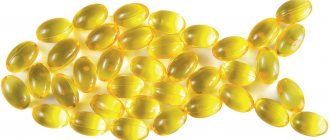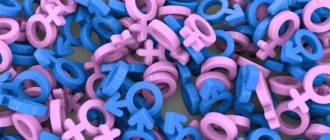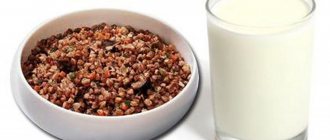What is the role of drinking water
The body is made up of 80% water; water directly affects the condition of the skin and internal organs. Water is responsible for the absence of wrinkles on the face, and the main thing here is to find your quantity. I think that you have seen on the Internet where they wrote about 3-6 liters of water per day? So - this is complete absurdity, I will now tell you a proven method that will never fail.
It sounds stupid, but still. Go to the toilet, start urinating, look at the color of the urine, if the urine is light or slightly yellow, it means that the water level in the body is in perfect order. It’s bad if your urine is clay-colored, then either you’re not drinking enough water, which can be corrected, but maybe it’s an illness, you should consult a doctor.
Slim body rule No. 2. Eat small meals
The bottom line. Eat small meals 4-5 times a day.
For what? Nutritionists consider fractional meals the most effective step towards a slim body. This not only speeds up your metabolism, but also protects you from hunger: a proper snack after a small breakfast will prevent you from wanting to eat a whole set lunch. In addition, large portions stretch the walls of the stomach, increasing its volume. What's next? That's right - overeating! But by eating little by little (150-200 g) every 2-3 hours, you will inevitably come to moderation in food and a slim body. Food will be digested completely, without being stored in reserve on the hips and waist.
Making a daily diet
I can give general recommendations, but it is impossible to schedule meal times for everyone! You must determine it yourself based on your free time throughout the day. Below we will talk about what protein, fats and carbohydrates are, and what benefits they have.
Now I’ll tell you about the best time to eat and what you need to eat to be healthy.
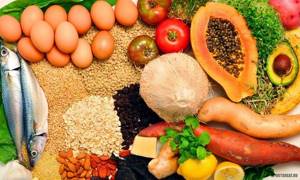
Be sure to start your morning with breakfast, after a glass of water. Between 7-9 o'clock in the morning, take more carbohydrates - this is any porridge, maybe oatmeal, buckwheat, wheat. You may ask why porridge and not soup, for example? I will say that the porridge contains a carbohydrate composition that gives energy for the whole day; it is thanks to carbohydrates that you have the strength to even just take a step.
Buckwheat, depending on the variety, contains 100 grams of product from 60 to 80 grams of carbohydrates. If you weigh 70 kg, you need 150 to 200 grams of carbohydrates per day.
Formula - take your weight, multiply it by 2 on average, and get the amount of carbohydrates needed for 24 hours.
List of foods and their carbohydrate content
Second meal 10-11 o'clock in the afternoon - consists of a snack, we eat fruits, dairy products, salads, a little chicken or beef.
13:00-14:00 hours. Lunch, it will be good to eat meat, side dishes, boiled potatoes, fish. Not exactly light, but not heavy products either. Don’t forget about fresh greens, they contain elements that help digest food.
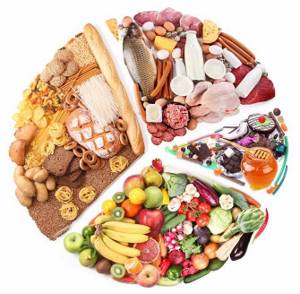
16:00-17:00 meat plus complex carbohydrates. What are complex carbohydrates, read below. You can include rice with meat, vegetables, fish, side dish, turkey.
Evening 19:00 after this time you can only eat vegetables or fruits. Take dairy products - cheese, fresh milk, semolina, yogurt, in short, foods that are quickly digested.
Proteins, carbohydrates, fats
3 main components, we cannot live without them.
- Proteins are found in almost all foods, with the exception of bread products or in small quantities. Most of all - meat and dairy products. High-quality proteins are found in chicken, turkey, and fish. Fast proteins (casein) are found in dairy products, most of all in cheese.
- Carbohydrates are a component that gives energy and strength for life, found in all products, divided into complex and simple ones. Complex ones are rice, buckwheat, wheat porridge, and cereal varieties. Simple and harmful - bread, pie, sweets. It is the simple carbohydrate that remains as fat.
- Fats are a component that is responsible for hair and nails; when losing weight, people often exclude this element from their diet, which is not necessary, hair may fall out and nails may crumble. Contained in pork and various fatty foods. 1 meal of pork per month will be enough.
Learning to eat right
An extremely strict diet is fraught with failure: sooner or later this will happen - just a matter of time. But this does not mean that sometimes you should not say a strict and unshakable “no” to yourself. How to learn to eat right and at the same time maintain the harmony of the “physical” and “emotional”? Let's look point by point. 1. Don’t wait until you’re in a state of “unbridled hunger.” It’s understandable that you should start eating hungry, and not because your colleagues from the next department called you. But you shouldn’t endure hunger for more than twenty minutes. Understand that when you really, really want to eat, you won’t be able to control yourself and will grab the first edible item that comes to hand—candy from a bowl, a pie from your grandmother. In addition, a person who is very hungry will eat much more than his stomach allows. The break between meals should not exceed five hours. It is possible to “usefully” interrupt “irrepressible appetites.” Eat an apple, drink a glass of clean water. Research by American scientists has shown that women who regularly have an “apple snack” before lunch consume 185 kcal less during the meal. 2. Never drink it with water. Nutritionists say that you can sip water directly while consuming food - in small sips. But after finishing lunch or dinner, you should absolutely not drink. The thing is that comfortable conditions have been prepared in the stomach for “processing” the absorbed products. By diluting the substrate, you disrupt digestion. The first glass of liquid can be sent into your digestive system no earlier than an hour after your meal. 3. Do not try to combine incompatible things. Certain foods enhance fermentation processes in the intestines even without “outside help” - these are cabbage, milk, grapes. Imagine what happens if you combine them in one meal? A real storm. Particularly incompatible are acidic and alkaline foods (tomatoes and milk, for example). But there are also “couples” that will not cause stool upset at all, but fresh deposits on the waist. And this, let’s not torment you, is a combination of high-carbohydrate and fatty foods. Just a week or two on sandwiches with lard and cakes, washed down with coffee with cream - and an immense aunt will flaunt in front of you in the mirror. Remember: any drinks - juices, coffee, fruit drinks, teas, compotes - go very poorly with food. They are good only in combination with fruits and dried fruits, chocolate and marmalade. It is better to dilute the wine you consume during meals by a third with water. You should not drink strong alcoholic drinks if your stomach is empty. 4. Taboos on snacking “for socializing” and “food” have become almost synonymous. But we should not forget that food is just a means by which normal “bodily” functioning is ensured. And this means only one thing: only the body has the right to determine when the next nutrient portion should be processed. Hunger is the only reason to sit down at the table to refresh yourself. Undoubtedly, sometimes you have to sit down at the festive table, whether you want it or not. But no one forces you to eat! Drink water or compote and enjoy communication! 5. Take your time It will be extremely difficult for the stomach to cope with poorly chewed food. In excessively rapid absorption of the contents of the plate lies the danger of “quickly” gaining weight. An increase in blood sugar levels is a signal of satiety to the brain. This signal is recorded approximately twenty minutes from the start of the meal. Scientists from one of the famous universities conducted one very interesting study. They recruited a group of student volunteers and asked them to eat two bowls of spaghetti with cheese. The first - as quickly as possible, the second - slowly, paying maximum attention to chewing food. So what's the end result? From the first bowl, the girls “managed” to get 646 kcal in just nine minutes, from the second bowl, 579 kcal in half an hour. It is worth noting that after a hasty lunch, the experiment participants complained that the feeling of hunger did not leave them. We hope we have convinced you that you definitely shouldn’t save time on food. Try to wean yourself from swallowing food quickly - replace the tablespoon with a dessert spoon, and a large fork with Chinese chopsticks. 6. Don’t put a whole mountain on your plate Since childhood, we remember that it’s a shame not to finish eating. When visiting, you cannot offend the hostess who cut you a truly huge piece of cake. There are people who adore order everywhere, even on their plates. This is how the habit of cleaning up everything you put down is formed. But you can solve the problem in a rather ordinary way - take a small snack plate instead of the usual one. 7. Do not eat in an emotionally excited state. As we have already noted, only the body has the right to encourage you to pick up a spoon. Neither reason nor emotions should have such a privilege. In “stress mode” it is extremely difficult to concentrate on the process of absorbing food - you risk going overboard with the quantity. Being excited and upset, you are unlikely to reach for a chicken breast and a slice of whole grain bread. After all, the soul asks for something especially tasty: sweet, fatty, aromatic... Do you feel bad after eating? Why be surprised, because you didn’t just overeat, you probably overdid it with sweets containing a huge amount of fat. Learn to find an outlet not only in food! 8. Immediately turn off the TV , as well as the player, computer, and phone. And put away the newspaper too. During a meal, you should pay attention exclusively to the food on the plate. Pay attention to your inner feelings. Until you are full, the taste will be juicy, bright, exciting. If you feel that the food is gradually becoming tasteless, it means it’s time to call it a day: you’re full. TV and other attributes will not allow you to grasp this fine line. 9. Fruits are not a dessert In the sense that finishing a meal with them is not entirely correct. Fruits do not go well with fish and meat, vegetable and cereal dishes. Wait an hour and a half to two hours after lunch before enjoying your favorite banana. Important! All fruits are best consumed before 18.00. 10. Don’t overeat You should leave the table with a slight feeling of hunger - everyone knows this. But practice shows that following this rule is very difficult for many. The diet of a modern person, unfortunately, is disordered. Try to plan in advance how much you are allowed to eat. Do not deviate from the planned volume of products even when visiting. It’s better to serve yourself a little bit twice than to “admire” a lush pile in a plate.
Option 1. Everything is possible, but in limited quantities
This option includes a wide variety of food on the menu, including fast food, but the portions will be small.
Besides, you won't be able to eat it all in the evening. This method of eating relies on counting calories and timing of meals.
You need to eat no later than 19:00. So, a person has a certain daily calorie requirement. He can fill them with any food, including fast food.
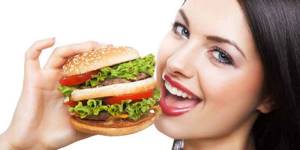
But, you need to be prepared for the fact that one trip to a fast food restaurant is enough to eat your daily calorie intake.
Therefore, it is better to eat all this not every day, but from time to time, diversifying the menu with other equally interesting, healthy and less high-calorie dishes.
Food and dishes
Perhaps the crux of the matter lies not in the eaters themselves, but in what is on the plate? In fact, how does food differ from food? Both are food. However, a plate of buckwheat with a cutlet is more likely a meal, but a delicacy served on a special occasion to dear guests is more likely a dish. Of course, this division is somewhat outdated; the borrowed foreign word “delicacy” is now used; it has firmly taken the place of “food” on festive tables covered with a snow-white starched tablecloth.
Even at the beginning of the last century, some hundred years ago, it was food that was served on the tables, and this included not only dishes, but also drinks. It’s unlikely that anyone thought about the correct way to eat or eat. However, after the revolution in October 1917, war was declared on everything noble and bourgeois. So under the Bolsheviks, people stopped eating and began to eat more prosaically.

List of foods for proper nutrition
The menu should include proteins, fats and carbohydrates, which take a long time to digest. It is better to remove easily digestible compounds from the diet.
Cereals
Cereals should be present in the daily menu, because... they are able to remove toxins from the body and cleanse the intestines, improving its functioning. The most useful crop is oats, which contain vitamins and amino acids that can lower blood cholesterol levels. If you eat this product in the form of jelly or porridge, the risk of gastritis and pancreatitis will decrease.
The healthiest grains:
- couscous – eliminates insomnia, copes with depression and improves brain function;
- quinoa – contains iron, phosphorus, zinc and calcium and helps strengthen bones;
- red rice – rich in B vitamins, iron and phosphorus;
- buckwheat – improves heart function, stimulates metabolism and immunity;
- wild rice - helps improve digestion and strengthen muscles;
- Bulgur – stimulates metabolic processes and helps remove toxins from the body.
It is also good to include millet in the menu, which improves kidney function and prevents a number of diseases of the urinary system.
Meat and fish
Anyone who eats right tries to exclude red meat from the menu, which takes a long time to digest and can ferment in the intestines, contributing to flatulence and other disturbances in the gastrointestinal tract. Instead, it is recommended to give preference to turkey, chicken and sea fish containing Omega-3 and -6 acids. You should not eat raw meat. It is better to steam the product with minimal addition of salt. Meat and fish can also be baked, but not fried.
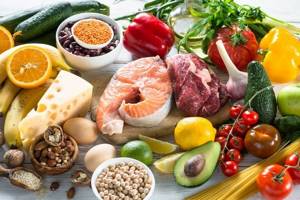
Vegetables
Vegetables should be eaten every day to compensate for the deficiency of vitamins and other nutrients. For gastrointestinal diseases, it is recommended to avoid cabbage, tomatoes, radishes and mushrooms. The healthiest vegetables:
- carrots are a source of retinoids that support healthy hair and skin, and also improve heart function;
- garlic is a natural antibiotic that destroys not only pathogenic microorganisms and parasites, but also has general strengthening and anti-inflammatory properties;
- onion – rich in essential oils and organic acids that can stimulate the immune system;
- bell pepper – contains a large amount of vitamin C, prevents digestive problems and prevents the appearance of malignant tumors;
- beets - improves the functioning of the liver, intestines and stomach, stimulates the removal of toxins from the body and replenishes the deficiency of iodine, potassium, iron and phosphorus;
- potatoes – contain important amino acids that help support the functioning of the immune system and improve digestion;
- broccoli – contains indole-3-carbinol, which reduces the risk of tumor diseases, prevents hormonal disorders and the appearance of endometriosis and breast pathologies in women;
- zucchini - rich in healthy fiber, vitamins B and C, calcium and phosphorus, which improve digestion, promote weight loss and strengthen bone tissue;
- eggplants – improve the condition of the cardiovascular system and help get rid of extra pounds;
- pumpkin is useful for diseases of the digestive system, heart and blood vessels and is included in the diet for obesity.
In addition to the above, it is important to include spinach in the menu, which stimulates the digestive system and contains a number of vitamins and minerals.
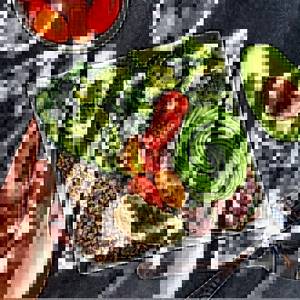
Fruits
Eating right means including as many fruits as possible in your diet, the healthiest of which are apples, which help improve digestion and stimulate the immune system. This product reduces the risk of heart attacks. Bananas are important for the human body because they contain a large amount of potassium, which prevents heart disease.
The menu should include:
- oranges;
- grape;
- pears;
- apricots;
- lemons;
- persimmon;
- peaches;
- kiwi;
- grenades;
A person needs to eat plant foods 2-3 times a day. If you eat 3 fruits a day, you can forget about colds, excess weight and high blood cholesterol.
Dairy products
If you eat fermented milk products, then you can forget about digestive problems. Kefir, cottage cheese, sour cream, cheese and yogurts have a beneficial effect on the condition of the intestines, prevent the occurrence of dysbacteriosis and saturate the body with calcium and protein. Fermented milk products should be consumed separately from other foods so as not to provoke flatulence.
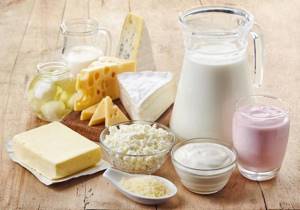
How to learn to eat right and lose weight. How to eat right to lose weight
The article contains simple advice from a nutritionist that will teach you how to eat properly to lose weight, general recommendations, and the most common mistakes and misconceptions.
- Alimentary (from the Latin alimentum - food, nutrition) is what we get through the mouth. In 95% of cases we eat up the problem.
- Endocrine disorders occur in 3-4% of cases.
- Various neurological disorders and other causes occur in 1%.
- BX. How much our body spends in order to maintain its vital functions at rest (lying, sitting, watching TV). The amount of energy consumed is individual. Calculated: women 0.9 kcal/kg, men 1 kcal/kg weight.
- Physical activity.
Why are we getting fat?
Causes of excess weight:
In other words, in 95% of cases the problem arises due to the excess of incoming energy over our energy inputs.
Energy costs come in two ways:
You cannot eat less than your basal metabolic rate.
Table of energy consumption by organs and tissues of the body
When basal metabolic rate increases:
- When gaining muscle mass.
- In stressful situations.
- With an increase in body and environmental temperature (bath lovers).
- With active growth.
What reduces metabolism:
- Age. Our task is to maintain metabolism through physical activity.
- Lactation.
- Endocrine diseases.
- Starvation. All the starvation diets that exist.
Formula for calculating the basal metabolic rate (BMR), where M is body weight:
When a person eats more than he burns, a calorie surplus occurs. For example, it is very easy to eat an extra 200-300 kcal. They are hidden in products that we do not treat as food.
Who thinks drinking a glass of milk is bad? This is the same 300 kcal of energy, that is, half a cheeseburger or hamburger. Milk and kefir are also food. Very often, a glass of kefir drunk in the evening is considered a dietary product. But if this glass goes beyond the daily ration, it’s already too much in calories.
A daily excess of 200 kcal leads to a gain of 8 kg per year.
Eating disorder
Types of eating disorders that occur in 60% of overweight people:
- Food for company. For example, a woman had dinner at five o'clock. My husband came at nine in the evening. The wife eats the second dinner for company.
- Emotional “food drunkenness”. Eating stress, replacing love with a tasty product. Sugar stimulates morphine zones in our brain, the same as drugs. The hand, like that of a drug addict and alcoholic, reaches out to this pleasure. There is no need to read books, go to the theater, play sports, build relationships, or look for sources of joy. He took it and ate it. You love yourself for a minute, then you hate yourself the whole evening.
- Restrictive disorders – “dietary depression”. It occurs in people who are constantly on diets, limit themselves, and go to bed thinking about food. Such people cannot stop once they get their hands on the goodies. In practice, it turns out to be a painful attempt to lose weight in order to eat cakes and buns. The habit of proper eating behavior is not developed.
- Paroxysmal disorders. For example, "night priestess". A one-time uncontrollable bout of overeating. Suddenly I wanted it - I attacked the food and was no longer able to stop.
Slim body rule No. 5. Avoid harmful foods
The bottom line. Don’t eat fast food, but try to find healthy alternatives to your favorite high-calorie treats.
For what? It’s stupid to dream of a slim body while constantly eating burgers and fries. However, you can gain weight from products that seem “safer” at first glance. Nutritionists advise excluding sausages, sausages, potato chips, and margarine from your diet. These foods are rich in trans fats, which can cause obesity and cardiovascular problems. Sugary drinks will not make your body slimmer: soda, packaged juices, alcoholic cocktails - all of them do not quench your thirst well, but they contain a lot of sugar, fast carbohydrates and “empty calories”. However, when striving for a slim body, it is not necessary to give up sweets completely: it is enough to replace cookies and waffles with dark chocolate or marmalade. Do you want ice cream? Prepare it yourself. Are you missing oriental sweets? Homemade ones are no worse than store-bought ones. The main condition: indulge in desserts no more than twice a week and only in the morning.
These simple principles will bring you closer to your cherished slimness. There is no need to change your lifestyle suddenly - on the contrary, for proper nutrition to become a habit, you need to act gradually. Next time we will tell you about five rules for a slim body that will help you not only lose weight, but also maintain the result.
Lean Body Rule #4: Cook Right
The bottom line. Give up cooking methods that do not bring you closer to a slim body.
For what? We all know that fried foods are harmful. But baking is not a panacea; it can increase the glycemic index (GI) of a product or convert carbohydrates from slow to fast. Therefore, if your goal is a slim body, switch to steamed, boiled or stewed food. And if you still can’t refuse fried foods, do not add oil to the pan, cook in a wok or use a grill.
How to learn to eat healthy menu. How to create a healthy nutrition menu for every day?
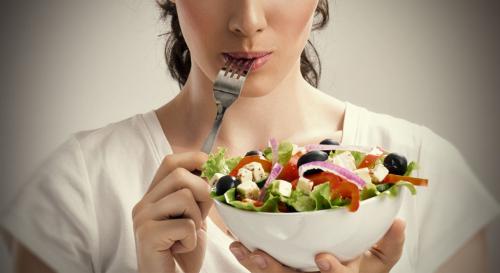
The first thing you should learn is to identify such a feeling, hunger. It is not at all strange that a large number of people do not understand at all how to explain why they constantly want to eat. And yes, learning to distinguish between feelings of hunger is more than possible, so don’t rush to be surprised.
Stretch your memory and remember how often you overeated at a banquet, at a friend’s birthday party, or tried to eat away disappointment or resentment. Even if your refrigerator is completely filled with healthy products, you will go to the supermarket and buy all sorts of nasty things to satisfy your hunger.
Have you noticed that you sin when you eat sweets, flour and fast food? That your daily diet consists only of chocolate, Coca-Cola, pasta and pizza? If yes, then this means that you have no idea what proper nutrition is. This can happen because you don’t know how to correctly recognize the feeling of hunger. How can one learn this?
It is worth remembering that appetite and hunger are completely opposite demands of your body.
In most cases, these concepts are confused, which is why they overeat. The feeling of hunger is a signal sent by the brain that your body is depleted and needs to replenish its “reserve” of nutrients. And appetite is a secretive desire to pamper your stomach with something. In order for you to better understand what it is, let’s look at an example.
Imagine an evening, you have a feeling that you need to eat. We boiled rice or buckwheat porridge, boiled chicken breast and ate. This is one example of proper nutrition in the evening. Afterwards, wash it all down with green tea without sugar. This means that you had a feeling of hunger, we conclude that satisfaction came after such a meal. Situation number 2, upon arriving home, you looked into your refrigerator, where there are cereals, broccoli, fruits, but you have no desire to eat them. At this moment, you would like to eat pizza, cola, Napoleon cake, crackers and nuts while watching your favorite movie, a kilogram of ice cream, chatting with friends on the Internet. This is a clear example of quenching the thirst of your appetite, the principle of which is basically “plentiful and tasty.” We can draw the following conclusion: if you are not satisfied with healthy eating, it means that your appetite is again being disrupted, and this in turn is an indicator that you are not hungry.
Rules for proper nutrition
Let's remember the rules on how to eat properly in order to stay healthy and vigorous for a long time.
- Meals should be regular. The best interval between meals is 3-4 hours. To train your body not to stockpile and normalize your metabolism, you need to evenly divide your diet into 5 meals. Breakfast, lunch and dinner are sacred. Moreover, breakfast should be complete - for example, porridge or cottage cheese. In between, you can have small snacks, but not tea with sweets and cookies. Or you can eat an apple or a carrot. You can also drink tea, but it’s better not sweet, and take raisins, dried apricots, and dates as a sweet addition. Or eat a handful of nuts.
- Take your time! Make it a habit to chew your food thoroughly. Because the digestion process begins in the oral cavity, here food is enriched with saliva and carbohydrates are broken down. The stomach, which has received poorly chopped food, is able to digest such food, hence the appearance of gastritis. You should allocate half an hour for eating during breakfast and dinner, and one hour for lunch.
- Reading or talking while eating distracts from the process of eating. We get distracted and consume much more food than required. And this will definitely affect your figure. You should not watch TV while eating, because along with food we absorb, as a rule, a lot of negative information. And by concentrating on food, more blood will flow to the stomach, thereby improving the digestive process in the stomach. If silence is annoying, then it is better to turn on soft, pleasant music.

- We know that our body, depending on age, consists of 75-85% water. A person can live no more than 3 days without water. Therefore, you should not expose your body to dehydration. A healthy person needs to drink 2 - 2.5 liters of water during the day. But try to drink water in fractions, 30 - 50 ml at a time. If you drink 2-3 large mugs of tea at once, you will only harm yourself and stretch your stomach. Train yourself to drink water at a comfortable temperature half an hour before meals. By doing this you will prepare your stomach for food intake and even deceive it: you will eat less food. It is not recommended to drink water while eating. If you feel that there is little saliva in your mouth, then you can take a sip of water.
- Try to start each meal with fresh vegetables or fruits. These can be various salads. All vegetables and fruits contain fiber, which promotes proper digestion of food in the intestines and normalization of microflora in the intestines. There is especially a lot of fiber in sauerkraut, apples, carrots, tomatoes, cucumbers, and bell peppers.
- Try to put a small portion on your plate. In order not to “overdo it,” for example, I serve it to myself on a small plate. Because usually everything on the plate is eaten. Or, when you feel full, leave the food on your plate.
- Don't give up bread. A piece of wholemeal black bread is very healthy; it is a source of B vitamins. Vitamin B2 (riboflavin) is necessary for growth and visual perception, and promotes wound healing. Vitamin B3 (niacin) is necessary for normal nutrition of nerve cells, skin and normal functioning of the gastrointestinal tract. Vitamin B6 (pyrodoxine) is necessary for protein metabolism and the normal condition of the skin, promotes growth and prevents the development of anemia. Vitamin E (tocopherol) is necessary for the body for the normal functioning of the gonads and muscle mass.
- Try to exclude various canned foods from your menu, especially factory-made ones, carbonated water, chips and other goodies with additives to improve the taste.
- Usually, when the stomach is full, blood rushes to the stomach to digest food, and, on the contrary, blood flows away from the head. Hence the desire to lie down and sleep after eating. It’s better not to do this, but to go and take a leisurely walk, this is also a kind of relaxation. And the extra calories will not be deposited on the stomach or waist.
- Sometimes you want something “tasty”; of course, you shouldn’t give it up. The body is such a wise instrument and usually it asks for what it lacks. Don’t torture yourself, even eat a cake or something high in calories, just try to eat it in the first half of the day. During the remaining half of the day, with active work, it will all burn out.
These simple rules on how to eat correctly will help you always be in good shape, and perhaps you will even lose weight. But I can tell you for sure, you will look great! No wonder they say that “we are what we eat.” Finally, watch a video about how to eat healthy.
Stylistic synonyms
These words are stylistic synonyms and are not completely interchangeable. Despite the absolutely identical semantic content, it’s worth figuring out whether to eat or not? How to speak correctly and in what situations?
The peculiarity of stylistic synonyms is that they are used to emotionally color an expression in different cases. For example, the well-known expression “The meal is served” may sound overly solemn or even pretentious, but this is an appropriate use of this word. If two businessmen, getting ready for lunch, say, “Let’s go and eat,” it sounds strange and hurts the ears. But the same phrase addressed to a small child fits most organically into the situation.

Nutrition rules before and after training
To learn how to eat properly before and after exercise, you need to understand how calories are burned and muscle mass is increased. You need to eat 2 hours before training. In this case, it is desirable that these be proteins: chicken, fish, dairy products. After classes, you can eat within half an hour. To lose weight, it is advisable to snack on foods containing plant fiber or cereals. But you can’t immediately after exercise eat heavy food, otherwise you won’t be able to lose weight.


